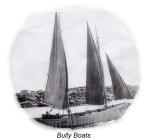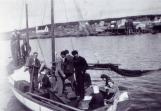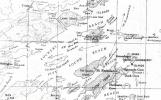2
The bully, the gallant little schooner of Central Bonavista Bay, was used in the early 1800s to mid 1900s. Like most Newfoundland-built boats, the bully came in many shapes and sizes. Furthermore, each master builder added special features to suit his fancy or the needs of the bully's owner. Often the bully was an extended-family boat used as a cooperative business asset by the family members.A typical bully might be thirty-eight to forty feet long, twelve to fourteen feet wide, six to eight feet deep. She might weigh ten to twelve tons and be fitted with two masts, a bowsprit and a cutwater. She would likely carry a mainsail, a foresail and two jibs. She might even carry a gaff-topsail and a windbag. Those used in the 1920s and afterwards usually featured a ten-to-twelve horsepower marine engine.
3
Gooseberry Island Bully1943
Gooseberry Island waters, Bonavista Bay, Newfoundland & Labrador, Canada
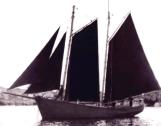
4
Here is a famous Gooseberry Island bully. As far as we know she was built on Gooseberry Island with Bill Parsons being the master builder. The Parsonses used her for fishing, coasting, cruising wood and to satisfy other family needs.6
The 'Gertie F' was built in the early 1900s. She was named after Gertrude, who was the youngest child of William Feltham from Deer Island. This bully was dearly loved by all of her users and looked upon as a family friend forever there to supply many of the family needs. In this sense the bully was par excellence the outport workaholic. William's extended family used this bully in many fishing ventures.Sometimes these ventures were enhanced with surprises. One summer day in the late 1940s, a group of fishermen returning home saw a "big fish." The man at the teller turned the bully to collide with it. The bully tipped on her side and the masts shook. The "big fish" was probably an Orca, more commonly known as a killer whale.
On another day, a crew member lit a fire in the forecastle stove using too much gasoline. The stove blew itself to pieces and in the explosion all the funneling dropped to the floor in rusted pieces. Luckily the bully didn't catch completely on fire, but it was a close call.
Whenever something unusual happened on a bully trip, the crew always told the story with gusto and often with amusement. Such story-telling was an important part of the oral transmission for which outport Newfoundlanders are famous.
8
The Bonavista Bay islands were isolated and the only practical means of everyday transportation was by boat. Because of its rugged seaworthiness, the bully was the boat of choice.10
Here we see a close-up of the reaches, sounds and islands of Central Bonavista Bay. The settled islands shown include Deer Island, Braggs Island, Gooseberry Islands, Cottel Island and Burnt Island Tickle. The bully was king of the ocean here, respected and cherished by all who knew her. Here the bully, workhorse of Central Bonavista Bay, served her owners in all aspects of their livelihood for more than half a century.Here on Deer Island Uncle Jim Feltham Senior slept lightly, uneasy because, though his bully was moored in Deer Island Tickle chained to her collar and with an additional anchor (her kedge anchor), he feared the anticipated gale might break her free. He got out of bed several times to check her out. Some time after midnight he missed the bully and knew the wind had carried her off. Not wanting his sons to venture out upon the sea in the dark, stormy night, he waited until it was nearly daylight to call them. At daylight they could see her spars some nine miles away outside Malone's Rock. His boys rescued her but it's still a mystery how she got out through the eastern tickle of Deer Island and past the shoals and breakers near Gooseberry Island without being wrecked.
Here it was a common occurrence for men to fall asleep aboard their bully on their way home from fishing. Sometimes a bully would be sighted headed in an unexpected direction, perhaps northwest instead of west. This happened most often on warm days with light breezes. Suddenly the bully, passing her home harbor, would turn, sails a -flutter, and head for the right tickle. The man at the tiller had awakened!
"The bully is coming", shouted from a high hill or an island point, most often meant that all was well: fathers, brothers and husbands had returned safely from the fishing grounds. Sometimes on Greens Island it was John Tite's bully, 'Pearl'; at other times on Deer Island it was Llewellyn Feltham's bully, 'Dreadnault'; it might be Uncle Sam's Bully; it might be the 'Gertie F' or the 'James and Sarah' of Feltham-family fame.
Many times the bullies got caught in sudden storms. These were sometimes the result of thunderstorms that moved to the north and blew up a blizzard from the north or northeast. In the late summer and early fall, fishing with no forecast to warn of tropical depressions moving along the coast, the bullies were caught at sea many times. Only the weatherglass (barometer) could give them any indication of an impending storm.
During these storms the bullies would sometimes make port at Flat Islands. They almost always ended up there when fishing outside the Offer Gooseberry Island. In order to get home to Deer Island in a northeaster they would have to sail around the north head to the windward of the Offer Gooseberry, which meant facing large swells with bow into the wind and on the broadside. The easiest way then was to go downwind or quartering to the lee of the line of rocks and small islands, which led from the Offer Gooseberry to the Inner Gooseberry. From there they were in the lee of Inner Gooseberry Island and St. Brendan's all the way to Flat Islands.
When these storms struck the men or crew closest to the bully got aboard first and tried to haul in the grapnel or chop the mooring. Then the other punts could be picked up on their fishing spot or on their way to the Bully. They would make their run south and southwest under reefed canvas around Offer Rock and Black Rock toward Flat Islands which were eight or nine miles south of Deer Island. Usually they arrived home when seas were favorable and were ready for the fishing grounds the next day none the worse for their ordeal. Sometimes they would lose the fish they left in the punts which were being towed, since they hadn't time to unload them or it was too rough to prong the codfish aboard the Bully. Several times punts were lost, never to be seen again. Other times they were filled with water and all the paddles and other movable items were lost. There were always extra punts, built locally of course, to replace lost or wrecked ones.
Stories of the bully are still told today with a smile and a touch of nostalgia. Her legacy is one of seaworthiness and durability in an era of sailing ships and courageous men and women.
11
The 'Gertie F' at her mooring1940
Deer Island Tickle, Bonavista Bay, Newfoundland & Labrador, Canada
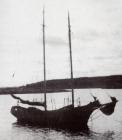
12
Newfoundland's poet, John Feltham, is a native son of Deer Island whose soul, like those of many other Deer Islanders, has never left its roots. As fisherman, student, teacher, school administrator, university professor and writer, John has always been proud of his heritage. Inspired by his family's bully 'James and Sarah,' named for his grandparents James and Sarah Feltham, he wrote the following poem. The 'James and Sarah' and the 'Gertie F,' very similar in construction, were built by master builder Noah Feltham.The Ballad of the Bay Bully
Her lines, would from a yachtsman
Cause no second glance
For she was built
Not to dally with balmy summer breezes
In sheltered inland reaches
But to dip her foredeck under the white water
Of full Atlantic gales.
If she perchance were caught
Upon the broad sea's bosom,
When unmeasured gusts from Greenland's icecap
Made puny sail and man's poor efforts nought,
Then strength of keel and knee and timber
Told what her fate would be.
The dank salt breath of many a hurricane
Fresh from the Gulf of Mexico,
Oft our wave-savaged shores have swept
And ever in their passing
Left vacant halves to marriage beds;
While in the graveyard grew
The number of empty lots
With tall, white marble stones.
The men whose hands and wills
Plotted her perilous path
Through storms and shoals
Had picked each tree
With crook and bend
To fit the curve along her hull
From raking stem to sturdy sternpost.
By the rippling rills of Trinity
Near a steep hillside stood
A mighty birch, whose crown in fifty years
Looked down upon the hill's bald top,
Its forty feet of limbless trunk
Was fashioned for a flawless keel
From Traver's whispering waters
Came many a spruce
Shaped by sun and snow and bog and frost,
For her stout timbers;
Each tree with natural bend
To fit the curve of hull.
Near a sharp bend in Content Brook
Grew balsam fir with trunks
As straight as sunbeams
From which came plank for bottom, deck and counter.
Her masts, two towering giants
For our eastern clime
Grew on a sandy point
Of Terra Nova's shore
And for full three score years
Vied with each other
In their climb
Towards the fleecy clouds;
Shaped and stepped in blocks of seasoned Juniper
To soar full forty feet above her deck.
Twice ten square miles of forest round
Were scoured for curve of bole and shape of root.
Axes rang clear from dawn to dark
To hew the resinous spruce and knotty juniper
And many a mighty fir
Fell crashing to the forest floor.
During the brisk November days
When chilly north winds numbed the nimble hands
That held the nails and hammers;
Her keel was laid
And fastened firm to stem and sternpost.
Timbers were added to the growing frame
Till December's shortest day
Found all in place.
Strong beams were laid from side to side
And bolted to the timber heads.
One by one, her plank from keel to bulwark
Were fitted edge to edge
Till her sleek bottom
Caught the eye of all who passed that way
And before the equinox brought lengthening days
Her hull was finished.
Under the April sun
Each seam was caulked with oakum
That left the smell of tar on knarly hands
For many a day.
The first spring tide of May
Brought men from miles around
To eye her curves
And launch her on the salty deep
Her natural habitat.
From spring to fall for many a year
She ranged the Offer Grounds
And many a day she dipped her bowsprit
In waves that rolled from Greenland's strand
Or broadside to an ocean swell
While under mooring
Rolled her rails under.
Her timbers creaked in protest
When the helmsman bore her down
Against the puissant pressure
Of a screaming squall
While with her lee rail under
She pushed the surging waves away
From frothing bow.
For years her keel had threaded
The runs between the rocks and breakers
Guided by the hands and instinct of her builders.
There were those who lightly claimed
That she could find her way
Without the guiding hand of man
From Luff-up to the Offer harries,
There was a time
Ere countless waves had caused her back to bend;
To prove the pundits right,
She broke her mooring in the island tickle
And drifted miles to sea
Through tickles scarcely wider than her beam
Amid a hundred breakers;
Shoals and islets
Where few men navigate
She had made her way alone.
A thousand trips she made
To ocean fishing grounds
Until her profile against the eastern sky
When dawning broke
Was part and parcel of the seascape
And her barked sails
When beating against a westerly
In the full rays of the setting sun
Told watchers on the island lookout
That once again she was returning
From her eternal quest for cod.
Time bent the backs and knarled the hands of her creators.
Time dulled their eyes and slowed their steps
Until no longer could they pit their strength and skill
Against the bitter ocean's blast
Or stand the creeping chill
Of hands immersed in ice-cold, Arctic currents.
Time and the countless blows from wind and billow
Have left their marks and altered her fair lines;
Until at last she found herself ashore
Keel deep in mud within a sheltered cove.
Dull land winds moan among her slackened shrouds
And throw frail ripples 'gainst her storm marked sides.
Day after day she lies unmoved by wind and billow
Dreaming of other days.
Days when her creaking masts
Were bent by press of sail,
Days when she wallowed on a windless sea,
Days when she labored under double reefs
To reach the shelter of her island harbor.
The winter ice has twisted plank and timber,
The ebb and flow of tides have bleached her paintless hull,
Now stained with rust streaks from each bolt and nail,
*Ooze-eggs and barnacles foul her fair flanks
And strings of oakum trail from open seams
But there are those who saw her in her prime
Cross the broad reach with every sail atrim,
Trailed by her flock of punts
Like a brood of ducklings
Following their mother's every move.
Saw her swift turn under the cliffs of Shoe Cove
And on her seaward tack
Point bowsprit for the breakers
That guard the "Owl's" flanks;
Heard the wild wind whistle through her rigging
In imitation of an orchestra
While she lay anchored on a shallow bank
Somewhere southward of the Offer Rock.
Her day is passed as in a muddy cradle
She waits for wind and water
To turn her bones to nothingness
Then like the men who shaped and sailed her
She will be just a dream,
A vague shadow of the half remembered past.
*Sea urchins
13
Mr. Donald V. Feltham Popplestone rock: well known to all Deer Islanders.1985
Deer Island, Bonavista Bay, Newfoundland & Labrador, Canada
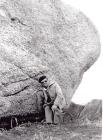
14
Glovertown's Donald V. Feltham has prepared a binder filled with pictures and words about the bully for the 'Glovertown Archives.' The binder is located in the 'Alexander Bay Public Library' at 'Glovertown Academy.'A native son of Deer Island, Don has many fond memories of the bully. Listen as he shares a few with you.
Transcription of sound clip:
"My memories of Deer Island, my childhood home are many and very dear to me.
They are memories of a boy at play and a boy also responsible for some household chores such as splitting kindling, keeping the wood box and water barrel full. I was also expected to help plant the vegetables in late spring and help harvest them in early fall. Work in the fishing stage and on the flake.
I was required to attend school regularly my parents impressing on me the need for an education to escape from the fishing boat "fishing was a dog's life" they said.
I was also required to attend church and Sunday school. No work was ever done or any sports played on Sunday. It was a day for family togetherness and visiting relatives.
My sports consisted of playing soccer, a game called cat (similar to baseball), hide and seek and tiddely. We rolled hoops, carried torches and flew kites. I rode the hills in winter on my home made sled or store bought coaster. I flipseyed on the small ice pans and foundered bally-caters. I cut and dragged boughs for our giant bonfire on November 5th.
I roamed the island climbing Popplestone looking for bird's nests or stranded squids in tidal pools. We scaled the cliffs and swam in ocean coves with running seas.
My parents worried but only cautioned. I was only carrying on Island tradition after all. It's all gone now and Deer Island is only an uninhabited speck in a wide ocean."
